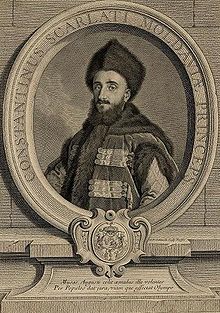- Constantine Mavrocordatos
-
This article is about Constantine Mavrocordatos. For other uses, see Constantine Mavrocordatos (disambiguation).
Constantine Mavrocordatos (Κωνσταντίνος Μαυροκορδάτος) Prince of Wallachia and Moldavia
Constantine Mavrocordatos, 1763Reign 1731–1733, 1735–1741, 1744–1748, 1756–1758, 1761–1763, 1741–1748, 1748–1749, 1769 Born 1711 Birthplace Constantinople, Ottoman Empire Died 1769 Place of death Wallachia Predecessor Scarlat Ghica Successor Constantin Racoviţă Constantine Mavrocordatos (Greek: Κωνσταντίνος Μαυροκορδάτος, Romanian: Constantin Mavrocordat; February 27, 1711 – November 23, 1769) was a Greek noble who served as Prince of Wallachia and Prince of Moldavia at several intervals. As a ruler he issued reforms in the laws of each of the two Danubian Principalities, ensuring a more adequate taxation and a series of measures amounting to the emancipation of serfs.
Contents
Life
First rules
Born in Constantinople (now Istanbul) as a Phanariote member of the Mavrocordatos family, Constantine succeeded his father, Nicholas Mavrocordatos, as Prince of Wallachia in 1730, after obtaining boyar support. He was deprived in the same year, but again ruled the principality five more times from 1731 to 1733, from 1735 to 1741, from 1744 to 1748, from 1756 and 1758 and from 1761 to 1763. He managed to regain control over Oltenia through the Treaty of Belgrade from 1739 after the Austro-Turkish War of 1737-39. He was the son of Mimia Mavrocordat and Ciuran Mavrocordat He ruled Moldavia four times from 1733 to 1735, from 1741 to 1743, from 1748 to 1749 and in 1769. He entered a personal rivalry with Grigore II Ghica; Ioan Neculce noted "Constantin-Voivode went lengths to replace Grigorie-Voivode's rule in Wallachia (...)", and subsequently "(...) as soon as they were seated on their thrones [during one of Constantine's rules in Wallachia], they began to quarrell and to report each other to the Porte without concealment".
Reforms and downfall
His reigns were distinguished by numerous tentative reforms in the fiscal and administrative systems, partly influenced by those of the Habsburg Monarchy during their presence in Oltenia; initiated in Wallachia, they were to be applied consistently in Moldavia as well.
He was responsible for the annulment of several indirect taxes, such as the văcărit (the taxation per head of cattle), and replaced them with a single tax of 10 löwenthaler, which could be paid in four annual "quarters". Faced with the exodus of serfs to neighbouring Transylvania, Mavrocordatos allowed them freedom of movement from one boyar estate to another, in exchange for a 10 löwenthaler fee (the effective abolition of serfdom: 1746 in Wallachia, 1749 in Moldavia).[1] At the same time, he imposed a quitrent, a the 12 days-corvée, and allowed the boyars a retinue of serfs (scutelnici) that were exempted from the state tax (and owed taxes only to their liege lord).[2] On these reforms as experienced in Moldavia, Neculce expressed his view that "were he not to have this heavy retinue of his father's, with all those insatiable people, and were he not prone on removing his cousin Grigore-Voivode from Wallachia, there would not have been such plunder in the country".
The prince attempted to impose a degree of centralism in the face of boyar privilege, and, despite boyar protests, created an administration which relied on a more professional, salarized apparatus, consisting of ispravnici he himself appointed to office, and who could act as judges; he also merged the traditional personal treasury of princes with that of the Wallachian administrative body, and decided to deny boyar title to families whose members no longer held official appointments.[3] In 1761, due to the reforms' effects, the Ban of Oltenia moved his seat from Craiova to Bucharest, leaving the region to be ruled by a kaymakam.[4]
Mavrocordatos was wounded and taken prisoner by the Russian troops of Catherine II, after his resistance in Galaţi during the Fifth Russo-Turkish War, on November 5, 1769. He was taken to Iaşi where he died in captivity. Despite their attempts to have the reforms overturned, boyars had to deal with their effects, as successive rulers confirmed the laws' scope.[5]
Preceded by
Nicholas MavrocordatoPrince of Wallachia
1730Succeeded by
Mihai RacoviţăPreceded by
Mihai RacoviţăPrince of Wallachia
1731–1733Succeeded by
Grigore II GhicaPreceded by
Grigore II GhicaPrince of Wallachia
1735–1741Succeeded by
Mihai RacoviţăPreceded by
Mihai RacoviţăPrince of Wallachia
1744–1748Succeeded by
Grigore II GhicaPreceded by
Constantin RacoviţăPrince of Wallachia
1756–1758Succeeded by
Scarlat GhicaPreceded by
Scarlat GhicaPrince of Wallachia
1761–1763Succeeded by
Constantin RacoviţăPreceded by
Grigore II GhicaPrince of Moldavia
1733–1735Succeeded by
Grigore II GhicaPreceded by
Grigore II GhicaPrince of Moldavia
1741–1743Succeeded by
Ioan MavrocordatPreceded by
Grigore II GhicaPrince of Moldavia
1748–1749Succeeded by
Iordache StavrachiPreceded by
Grigore CallimachiPrince of Moldavia
1769Succeeded by
Russian occupationNotes
References
 This article incorporates text from a publication now in the public domain: Chisholm, Hugh, ed (1911). Encyclopædia Britannica (11th ed.). Cambridge University Press.
This article incorporates text from a publication now in the public domain: Chisholm, Hugh, ed (1911). Encyclopædia Britannica (11th ed.). Cambridge University Press.- Neagu Djuvara, Între Orient şi Occident. Ţările române la începutul epocii moderne, Humanitas, Bucharest, 1995
- Constantin C. Giurescu, Istoria Bucureştilor. Din cele mai vechi timpuri pînă în zilele noastre, Ed. Pentru Literatură, Bucharest, 1966
- Ion Neculce, Letopiseţul Ţării Moldovei, Chapters XXIII-XXV
Categories:- 1711 births
- 1769 deaths
- People from Istanbul
- People of the Ottoman Empire
- Mavrocordatos family
- Rulers of Moldavia
- Rulers of Wallachia
- 18th-century Greek people
- Rulers of Moldavia and Wallachia
Wikimedia Foundation. 2010.

